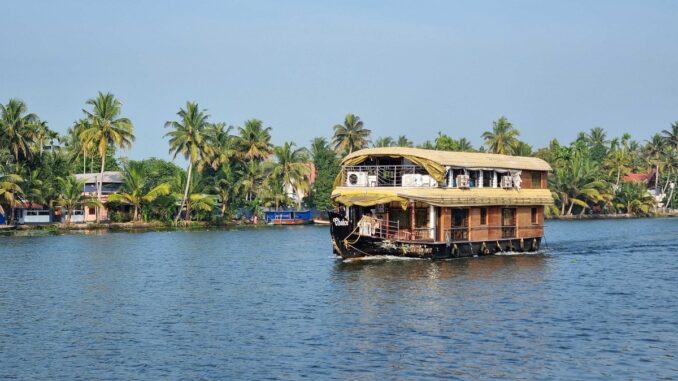
Mark Nicholls heads to southern India to explore the fertile landscape of Kerala.
It is a region of India they call “God’s Own Country.”
The description fits for the wonderfully diverse landscape of Kerala; from its vibrant cities and harbours; the tea and spice plantations; long coastlines; the famous Backwaters; and a culture that has been shaped and influenced over the centuries by Chinese, Dutch, Portuguese and British explorers and settlers.
Yet it is also pertinent to ask, “which god?”
Within Kerala’s population of 35 million, 55 percent are Hindu and 27 percent Muslim, but it also has India’s biggest Christian community (18 percent), underlined by the presence of so many lovely, white-painted churches.
With Kerala, however, the answer to “which god” lies in Hindu mythology and the story of how Parasurama, an incarnation of the god Vishnu, is said to have thrown his axe across the sea to create the land of Kerala and claim it from the ocean.
Early traders
Ports such as Kochi and the inland tea and spice plantations were the lure for early traders, and they remain so for visitors today.
Set on the famed Malabar coast, the sea inevitably dominates this long thin state in south-western India, having crafted the coastline and the Backwaters.
Kochi, previously known as Cochin, is a perfect introduction to Kerala. Relaxed and attractive, it is a city of islands, inlets and waterways, where ancient Chinese fishing nets are still used alongside modern fishing techniques and nestle in view of the modern container port which underlines the region’s prosperity.
I joined a group from tour company Explore! to spend eight days discovering more about the region.
From a base at the atmospheric Fort House Hotel on the waterfront, I boarded a harbour cruiser as a perfect introduction to Kochi, a city which traces its modern guise to the Portuguese who established a trading port in 1505, making it the earliest European settlement in India.
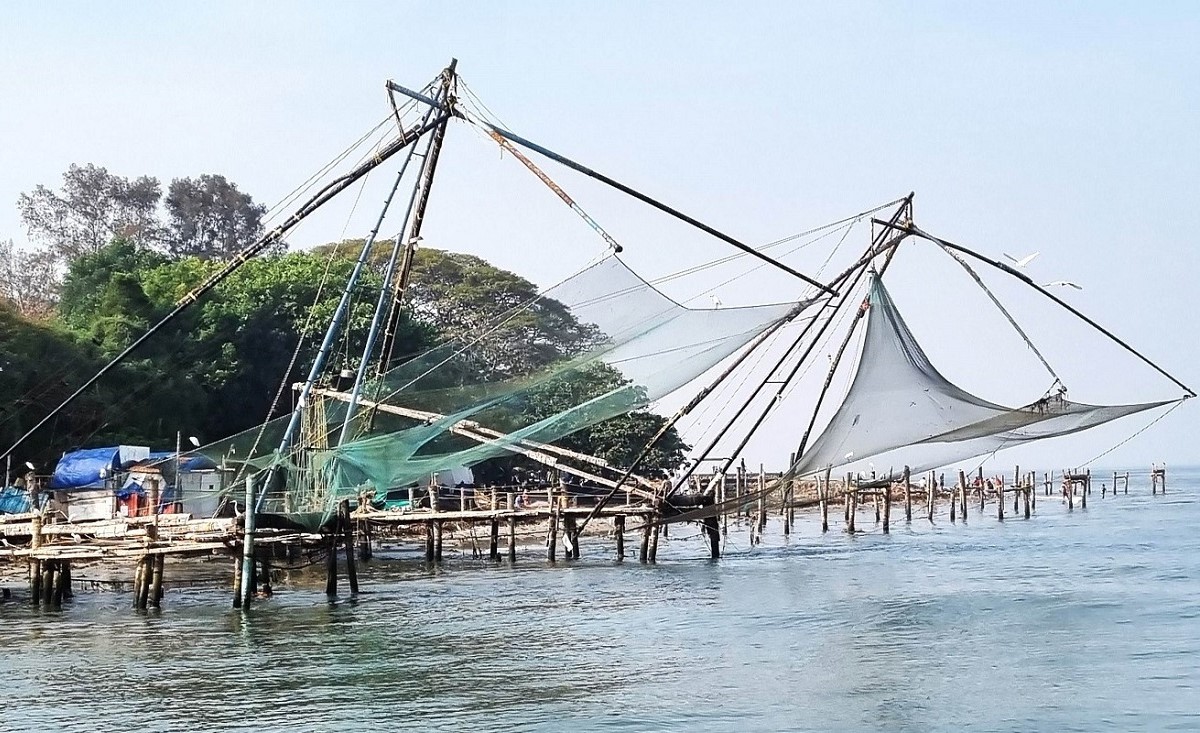
Chinese fishing nets
The sprawling Chinese fishing nets are symbolic of Kochi and an important element of the local fishing industry and were already a feature of the harbour before the Portuguese arrived, having first been introduced in the 14th century by Chinese settlers.
The cantilevered constructions are lowered into the water at high tide, counter-balanced by giant stones, and then hauled up to assess the catch.
Located at strategic points on the shoreline, as you motor on you see conventional fishing vessels moored under the bridges that now link the islands and mainland, or in small harbours, waiting to head out to sea for week-long fishing ventures.
As they prepare, the air is punctuated by the chop-chop of two-stroke engines powering ice crushing machinery to preserve the mackerel, tuna and sardines that will fill the hold.
Palaces and synagogues
The Fort and Mattancherry areas of Kochi can be explored on foot where you can absorb the relaxed cosmopolitan ambience of the city.
While little remains of the Portuguese fortress, the area is busy with stalls for snacks and souvenirs, or simply watching fishermen raise and lower the Chinese nets.
Mantancherry, with more shops and lovely cafes, hosts Kochi’s Jew Town where hundreds of Jewish families lived in the past.
Today, few remain and only two synagogues are active, including the renowned Paradesi synagogue.
The nearby Mattancherry Palace, built by the Portuguese and rebuilt by the Dutch, contains artefacts such as a collection of palanquins as well as impressive wall murals which depict stories from the Hindu epic the Ramayana.
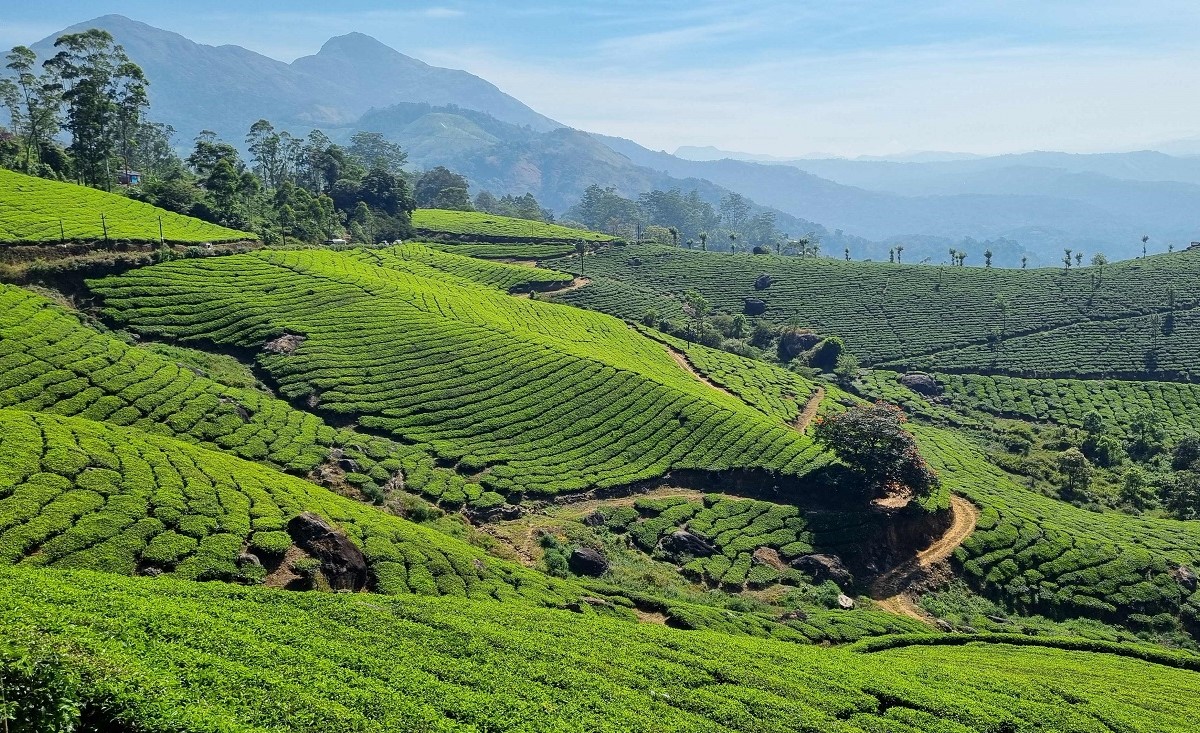
Communism and Christianity
Modern Kerala was formed in 1956 by bringing smaller states such as Cochin and Malabar together, with the population then becoming the first in the world to democratically elect a Communist government.
While not continually in power since the 50s, the current government is Communist led and you will see the hammer and sickle insignia on flags and walls.
The multi-faith culture of Kochi is evidenced by the early morning call to prayer from mosques which nestle alongside Christian churches, including the Cathedral of Santa Cruz or the white-painted Church of St Frances.
In one of the aisles lies Vasco da Gama’s tomb, the initial resting place of the Portuguese explorer, who was among the first Europeans to reach India by sea, though it was Pedro Alvares Cabral who was pivotal in establishing Portuguese influence in Kochi.
Vasco da Gama died in Kochi on Christmas Eve 1524, but his body was returned to Lisbon in 1539 for reburial in a far grander tomb in the Jeronimos Monastery.
You will also see Hindu temples across the region, such as the Mullakkal temple in Alleppey.
Tea and spices
As you head inland and climb into the hills towards towns such as Munnar at some 1500m above sea level, you enter a beautiful green landscape of tea plantations, where leaves from the bushes are picked, dried, and finely cut for tea.
The town is busy with a marvellous market of fresh produce with lush vegetables, fabulous fruit, coconuts, garlic, dried fish, paan, chillis, chai stalls, and roadside vendors cooking the famous Kerala parotta flat bread, while men on corners weave marigold garlands.
This is also India’s spice garden when you can see, taste, and smell the richness of cardamon, cloves, pepper, and nutmeg among many other spices…and, of course, buy too!
It is these spices which attracted traders to the region over several millennia, with its climate and landscape – particularly towards Thekaddy – so well-suited to spice cultivation at an altitude of 600-800m, with regular rainfall and a temperature generally below 35˚C.
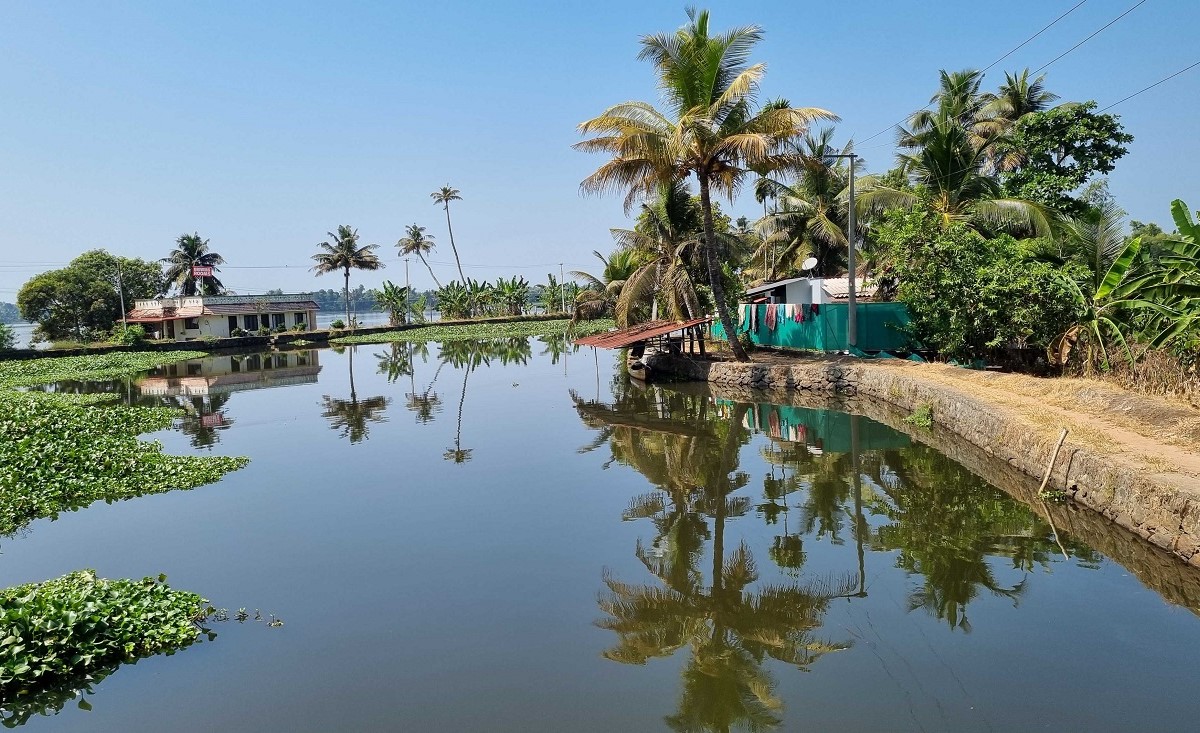
Cardamon pods
Cardamon is a native plant and grows as berry-like pods just above the ground on leafy plants, with the spice harvested every 45-50 days throughout the year.
Each spice pod is collected individually by pickers who know exactly when they are ripe.
Spice expert Sundheer Pa tells me:
“This area is the spice belt of Asia because the climate and conditions are so well suited to growing spices.
“Cardamon is the main crop and is used in cooking and for tea, particularly to make masala chai. You also see nutmeg growing for cooking and ayurvedic medicine as well as pepper.
“Pepper plants can last for up to 40 years and the different aromas can depend on the rainfall, soil quality, and can be strong, mild or sweet, depending on when harvested.”
Rice and coconuts
As you return to sea level past fields of pineapples and banana plantations, you see the two other staples of the Keralan economy: rice and coconuts.
Alongside rivers and the Backwaters of Kerala – such as around Alleppey – coconut palms line the banks and provide cooking ingredients within the local diet and coconut water, which is deliciously refreshing to drink, while the fibres are used to make coir mats or rope. Coconut is also used to produce toddy, the local alcohol.
Paths bordered by palms meander away from the waterside through rice fields which create a vivid green spectacle with workers in umbrella hats tending the crop, which has two harvests a year.
Homestays
As part of the Explore! tour, I spent a couple of nights in a family home on the Kainakary river near Alleppey.
Homestays are increasingly popular throughout India and particularly prevalent in Kerala, where you stay in a family home and enjoy home-cooked meals and gain an insight into Indian family life.
It’s a great chance to savour an Indian breakfast of masala dhosa and sambar or south Indian curries.
Food is always an important element of a visit to India, and in Kerala the emphasis is on fish and seafood.
While at the homestay, you may learn a new skill, such as how to put on a sari, or make the perfect chapati, which I attempted under the guidance of hosts Matthew and Simi Jacob.
From the veranda of the waterside homestay, you can watch small boats and ferry locals from one side to the other or drop children at school.
Venturing into Alleppey – known as Alappuzha – there is a long sandy beach, an impressive lighthouse, canals and Hindu temples, such as the Mullakkal temple.
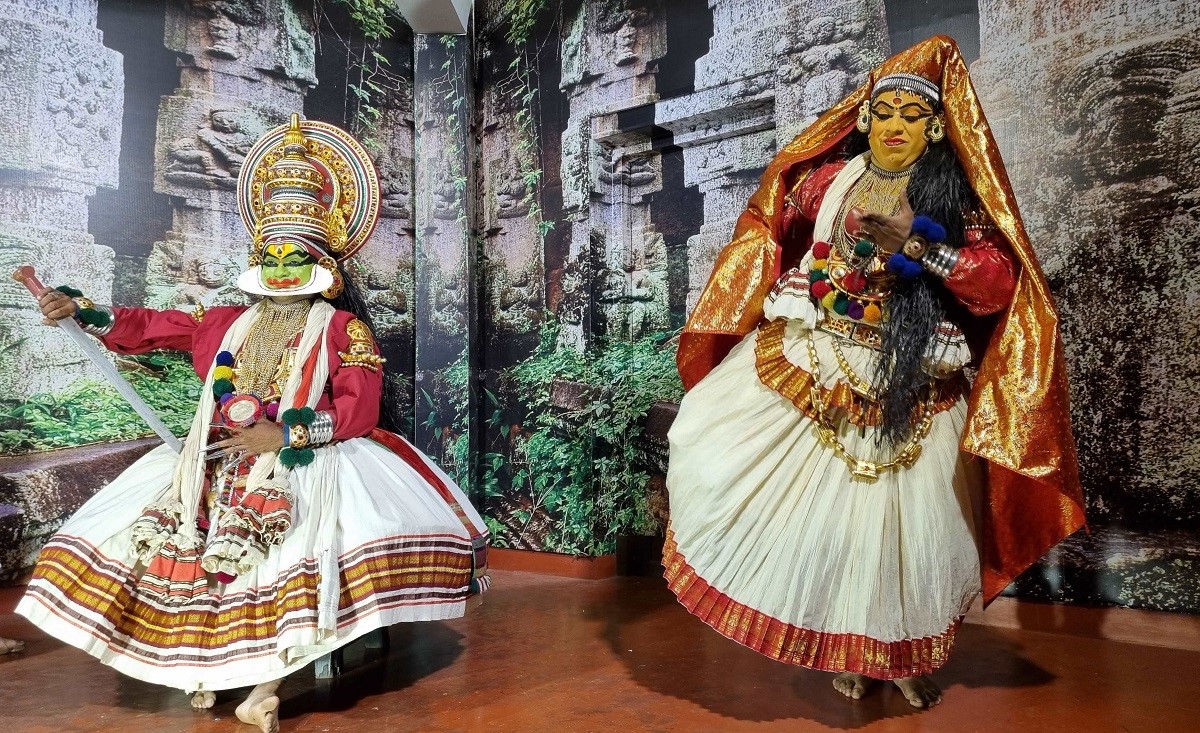
Backwaters and houseboats
Cruising the waterways of Kerala’s Backwaters aboard a houseboat is an idyllic way to relax and enjoy the network of lagoons, lakes, rivers and man-made canals which lie parallel to the Arabian Sea.
They were formed by the action of waves and shore currents creating low barrier islands across the mouths of rivers flowing down from the Western Ghats range.
Extending virtually half the length of Kerala, there are 34 Backwaters covering more than 560 miles of waterways.
Houseboats are surprisingly comfortable with ensuite bedrooms, a dining area and space on deck to enjoy the ambience as you motor sedately through palm-lined waterways.
Kathakali dancing
One of Kerala’s best-known cultural traditions is Kathakali dancing – instantly recognisable for the gaudy green paint of the male character and the demonstrative body movements that accompany the performance.
Bulging eyes and intense facial expressions, enhanced by the vivid make-up, are an integral part of the dance.
Demonstrations offer the chance to watch the performers apply their make-up and then explain the movements before a dance, which usually portray stories from the Indian epics of the Ramayana and Mahabharata.
The scenes, accompanied by singing and drumming, are a mere snapshot of full performances, which last for hours and run through the night.
It is a spectacular introduction to Keralan culture in a land of Chinese fishing nets, tea plantations, coconuts, spices, rice fields, and the Backwaters created by an axe-throwing god.
Factbox
Mark Nicholls joined Explore’s eight-night Kerala Backwaters tour, which costs from £965 per person including accommodation with breakfast and some additional meals, and a tour leader throughout. Flights are not included but cost from £846 per person. (Air India flies direct from London Heathrow to Cochin International Airport). For more information please visit: www.explore.co.uk/holidays/kerala-adventure.
Mark Nicholls is an award-winning freelance travel writer and author, based in the UK and has written for a range of national titles, specialist magazines and international websites and operated as a war correspondent in locations such as Iraq and Afghanistan.
Photographs by Mark Nicholls


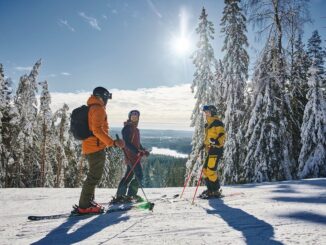
Be the first to comment